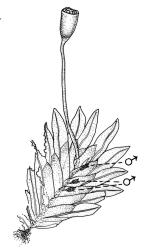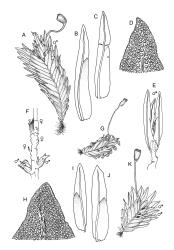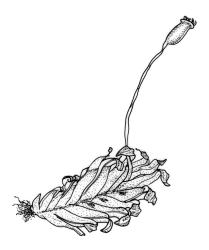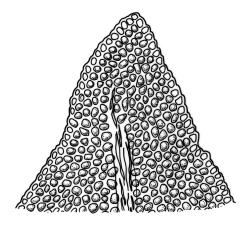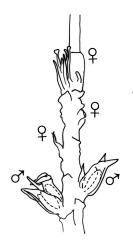- ≡ Fissidens oblongifolius var. hyophilus (Mitt.) J.E.Beever & I.G.Stone, New Zealand J. Bot. 36: 84 (1998)
- = Fissidens arboreus Broth., Öfvers. Finska Vetensk.-Soc. Förh. 33: 95 (1891)
Plants 4–10 mm, mid to dark green, in scattered clusters or densely gregarious. Stems frequently branched by means of innovations from below terminal gametoecia, with rhizoids at base only. Leaves in 10–15(–17) pairs, overlapping at mid stem, patent, plane when moist, with apices inrolled away from the substrate when dry, lingulate, 1.5–2.5 × 0.3–0.4 mm; apex obtuse to abruptly acute, frequently asymmetric; laminae unistratose; vaginant laminae c. ½ leaf length, partially closed to closed; dorsal lamina failing above or reaching leaf insertion, truncate at base; margins serrulate-crenate on apical, dorsal and vaginant laminae with cells of supra-basal vaginant lamina margins isodiametric to oblate; cells of apical and dorsal laminae irregularly hexagonal, smooth, strongly bulging, with moderately thick walls, (5.0–)7.0–9.0(–10.5) × (5.0–)7.0–9.0(–10.5) µm. Costa failing below leaf apex, oblongifolius-type in cross-section.
Gonioautoicous. Perichaetia terminal on main shoots and innovations, with occasional scattered naked archegonia or additional perichaetia in axils of subterminal leaves; perichaetial leaves narrower than vegetative. Perigonia bulbiform, axillary in distal parts of shoots, inconspicuous. Setae light brown, slender, strongly twisted when dry, 2.5–3.5 mm; capsules inclined to erect, slightly asymmetric, 0.5–0.8 mm; operculum rostrate from a conic base, equal in length to theca. Peristome similiretis-type, with teeth 52–65(–70) µm wide at base. Calyptra smooth, mitrate. Spores 10.0–13.5 µm.
Beever & Stone 1998, figs. 2, d–e, 5, e, 7, c, fig. 10; Beever et al. 2002 (as F. oblongifolius var. hyophilus), p. 48, figs 1–6.
The placement of F. hyophilus in the synonymy of F. oblongifolius by Bruggeman-Nannenga et al. (1994) is not accepted here.
While similar to both F. oblongifolius and F. capitatus, F. hyophilus is easily distinguished from them when dry, as its leaf apices are inrolled away from the substrate. When fruiting the smaller and inclined to erect near-symmetric capsules and shorter setae are diagnostic for F. hyophilus; likewise its preference for bark or dry rock as substrate.
Fissidens tenellus is the only other N.Z. Fissidens likely to be found growing directly on the bark of living trees, but that is a much smaller plant, with leaves little altered when dry. The occasional asymmetric leaf apex in F. hyophilus also helps to distinguish it from F. tenellus.
K; NI: N Auckland, including offshore islands (PK, GB), S Auckland (Mayor I.), Hawke’s Bay (Māhia Peninsula), Taranaki (Rātāpihipihi Scenic Reserve), Wellington (Percy Scenic Reserve, and KA); SI: Nelson (Tākaka), Marlborough (Kaikōura); Ch.
Anomalous. Mainland Australia*, New Caledonia*, Taiwan*. Recorded from Japan (as F. formosanus) by Iwatsuki & Suzuki (1982) and from Vanuatu (as F. oblongifolius var. hyophilus) by Suzuki & Iwatsuki (2002).
Fissidens hyophilus is most often found in indigenous forest, either on bark or rock. As an epiphyte it is most commonly on large boughs, trunks, and exposed roots; the most frequently recorded host species is Melicytus ramiflorus, but Litsea calicaris, Metrosideros kermadecensis, Planchonella costata, and Vitex lucens as well as Rhopalostylis baueri and R. sapida are also recorded hosts. As an epilith it occurs on a wide range of rock types: rhyolite (including rhyolitic pumice), serpentinite, granite, greywacke, limestone, and obsidian. Associated mosses include: Braithwaitea sulcata, Echinodium umbrosum, F. tenellus var. australiensis, Haplohymenium pseudotriste, Hymenodon pilifer, Lopidium concinnum, Pendulothecium punctatum, and Thuidiopsis sparsa.
Records range in elevation from 10 m in the bottom of the caldera on Tūhua/Mayor I. to 516 m on the Kermadec Is.
The species (as F. oblongifolius var. hyophilus) is classified as "Naturally Uncommon" in the N.Z. Threat Classification System (Glenny et al. 2011).
An account of F. hyophilus (as F. oblongifolius var. hyophilus) in N.Z. was given by Beever & Stone (1998).



